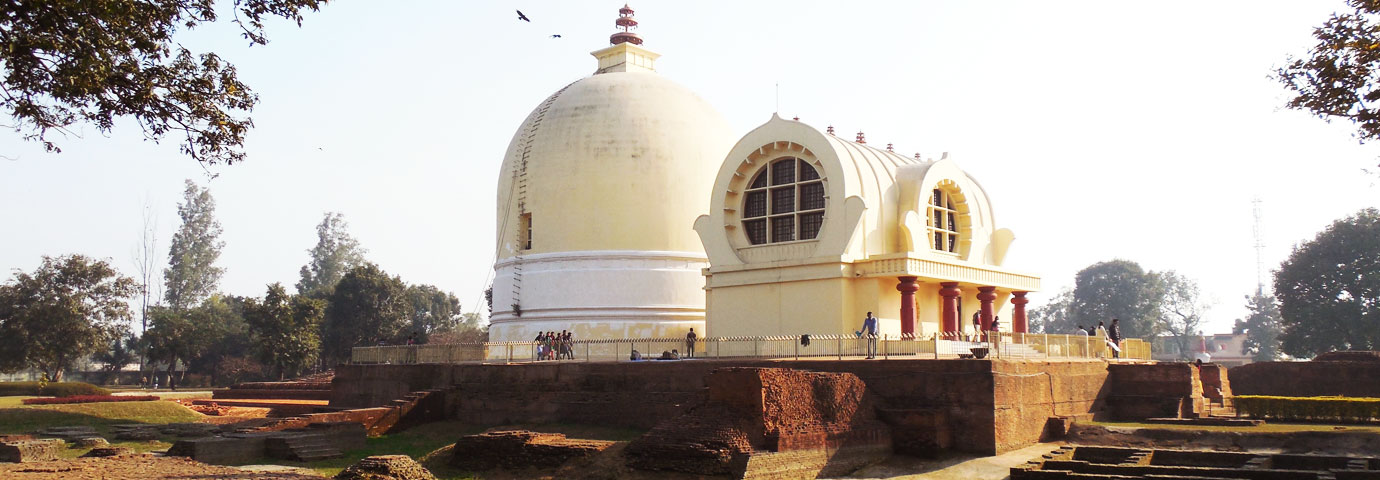Fast Facts
|
Area |
6.0 sq km |
|
Altitude |
400 m above sea level |
|
Language |
Hindi and English |
|
Best time to visit |
October to April |
Once in Kushinagar, it appears that time has come to a complete halt. This sleepy town, with its serenity and unassuming beauty, absorbs visitors into a contemplative mood. It is this place that the Buddha had chosen to free himself from the cycles of death and life and, therefore, it occupies a very special space in the heart of every Buddhist.
Location
Kushinagar is situated in the north Indian state of Uttar Pradesh, 51 km off Gorakhpur. The place, which is famous for the Mahaparinirvana (death) of Lord Buddha, has been included in the famous Buddhist trail encompassing Bihar, Uttar Pradesh, and Nepal.
Best Time To Visit
Like other places in the Gangetic plain, the climate of Kushinagar is hot and humid in the summers (mid-April-mid-September) with maximum temperature touching 40-45°C. Winters are mild and minimum temperature in December can go down to around 5°C. Monsoon reaches this region in June and remains here till September.
History
Kushinagar is also known as Kasia or Kusinara. The founder of Buddhism, Lord Buddha passed away at this place near the Hiranyavati River and was cremated at the Ramabhar stupa. It was once a celebrated center of the Malla kingdom. Many of its stupas and viharas date back to 230 BC-AD 413. when its prosperity was at the peak. The Mauryan emperor Ashoka added grandeur to this place by getting the magnificent statue of Buddha carved on a single piece of red sandstone. Fa Hien, Huen Tsang, and I-tsing, the three famous Chinese scholar travelers to India, all visited Kushinagar.
With the decline of Buddhism, however, Kushinagar lost its importance and suffered much neglect. It was only in the last century that Lord Alexander Cunningham excavated many important remnants of the main site such as the Matha Kua and Ramabhar stupa. Today, people from all over the world visit Kushinagar. Many national and international societies and groups have established their centers here.
Tourists Attractions
The Mahaparinirvana Temple, with its world famous reclining statue of Buddha, is an important site to visit. The 20-feet-long statue is seated on a brick platform. Ruins of as many as eight monasteries are around the main site. These monasteries have witnessed the rise and fall of a number of dynasties and the spread of Buddhism. Ruins of two monasteries-Mahaparinirvana Vihara and Makutabandhara Vihara-are especially famous. The Makutabandhara Vihara is believed to have been built by Malla kings to preserve the relics of the Buddha. Through the centuries, monuments and shrines of various types grew around these ancient sites.
Then there is the wonderful mini-city of Wat Thai Kusinara developed by the Thais. Built on an area of about 10 acres, it houses small huts, a school, a library, and hospitals. In the miniature gardens, lotus ponds and nurseries, all in typical oriental style, residents learn to love nature-the true gospel of Buddhism. Hundreds of Thai people come down every year to perform various kinds of services. The rich and poor alike, with clean-shaved heads and dressed in saffron clothes, live in modest huts and eat from banana leaves.
All holy sites are along one straight road. Towards the east, several temples of various Buddhist countries have come up. The procession organized by the Burmese temple every year on Buddha Poornima day is attended by thousands of people. Other attractions are the Indo-Japanese-Sri Lankan Center for Cultural Association, meditation center, and archeological museum. Nature lovers can take a strip to the Tamkuhi forest area, which also has a forest rest house for staying overnight.
Places Around Kushinagar
Fifty-one kilometers off Kushinagar is Gorakhpur, an important city of eastern Uttar Pradesh. At Gorakhpur is the Rahul Sanskrityayan Museum, which has an excellent collection of Thanka paintings and relics of the Buddha. The water sports complex at Ramgarh Tal Planetarium and the Gorakhnath Temple in the city are also worth a visit.
Kapilavastu (Piprahwa) is situated 148 km from Kushinagar and is an important Buddhist pilgrimage. Kapilavastu was the ancient capital of the Sakya clan ruled by Gautama Buddha's father.
Situated in Nepal at a distance of 122 km from Gorakhpur, Lumbini is the birthplace of Lord Buddha. There are regular buses to the Nepalese border, from where the remaining 26 km has to be covered by private vehicles.
Fairs & Festivals
Buddha Poornima is the most important festival celebrated in April/May. Thousands of people come to Kushinagar to celebrate the three most important stages of Buddha's life-birth, enlightenment, and death.
How To Reach
By Air - The nearest airhead is located at Varanasi from where one can take flights to Delhi, Calcutta, Lucknow, and Patna.
By Rail - Kushinagar does not have a railway station. The nearest railway station is at Gorakhpur (51 km), which is the headquarters of Northeastern Railways and linked to important destinations. Some important trains to Gorakhpur are Bombay-Gorakhpur-Bandra Express, New Delhi-Barauni-Vaishali Express, Cochin-Gorakhpur Express, Shaheed Express, Amarnath Express, and Kathgodam Express.
By Road - Kushinagar is well connected to other parts of the state of Uttar Pradesh by bus. There are regular buses to Gorakhpur (51 km), Lumbini (173 km), Kapilavastu (148 km), Sravasti (254 km), and Sarnath (266 km), and Agra (680 km).


